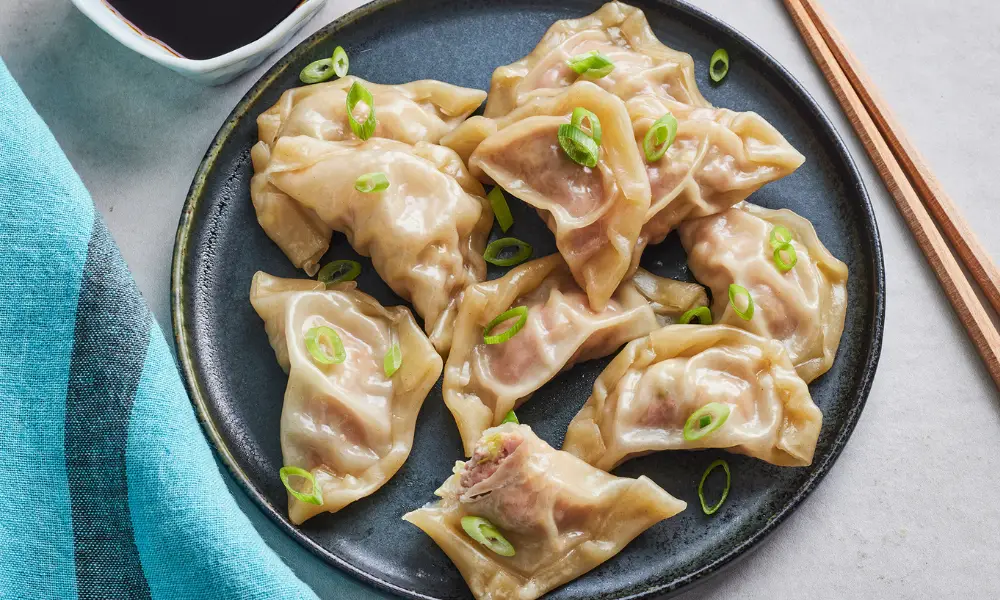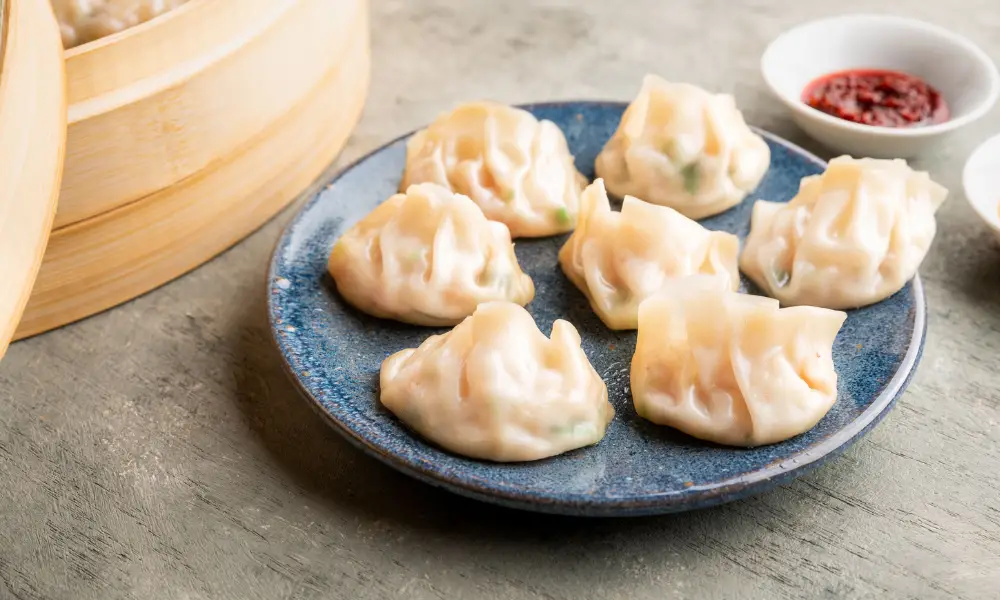If you’re curious about the many reheating methods for dumplings. This comprehensive manual provides advice on heating dumplings. Additionally, you will learn how to store your preferred foods.
Dumpling reheating can be rather scary. Though fairly delicate, they are nevertheless very tasty. Follow this advice, and you won’t have to worry about the reheated dumplings being soggy.

What Precisely are Dumplings?
When making sweet Chinese dumplings, Chinese dumplings are comprised of a dough wrapper with either filling or dough without filling. When producing savory Chinese dumplings (Jiaozi), the basis of the dough can be made from bread, flour, or potatoes, and the filling can be made from a combination of meat, fish, cheese, vegetables, or fruits.
However, they are also produced in Japan, where they go by Gyoza. There are different versions in other Asian nations like Sri Lanka, Thailand, and Vietnam.
How to Reheat Dumplings?
It’s a little more difficult than you may expect to reheat dumplings. Getting them right is difficult, so you can properly reheat the leftovers.
It can be frustrating to bite into a warmed dumpling with a nice warmth only to discover a frigid filling.
- Pre-cooked dumplings must be considered while selecting how to reheat. For me, the best way to reheat them is to utilize the same cooking technique you used when you originally made them.
- However you choose to reheat the dumplings, you must constantly consider the wrapper’s thickness and integrity. Also, be careful while handling dumplings that are thinly wrapped.
- I have tried various reheating techniques and have prepared and reheated tens of thousands of dumplings.
- The finest outcome was obtained when I steam them.
- Or microwaved – quick but with mediocre results.
- Re-boiling had the poorest results.
- However you decide to reheat them, you must always remember that they are quite delicate and require handling with care.
The wrapper will crack if you handle it roughly or if the heat is too intense, allowing all the delicious stuffing to spill into the pan. Pick the right strategy.
The three methods I described above for reheating dumplings. The trick, as previously said, is choosing a reheating technique while considering how you initially cooked them.
Reheating Steamed Dumplings
My experience has shown that steaming is the most effective method for reheating previously cooked dumplings. Please reheat them slowly, though.
Do you know what could happen if you use too much force and the wrappers are very thin? The filling will leak out as they crack.
Here’s How:
- Place parchment paper inside the steamer’s base. To ensure that the steam reaches the dumplings, ensure the edges have air spaces (or perforated holes) for heat circulation.
- Place the lid on. It ought to fit snugly.
- For many minutes, steam to thoroughly warm. 70°C should be the interior temperature.
Reheating Pan-Fried Dumplings
If you’ve never heard the term “potstickers,” it refers to pan-fried dumplings. The wonderfully crispy bases of potstickers are one of their main draws.
Because steaming them would make them soggy, it is not recommended. They can only be reheated in the pan again to maintain their delicious crunchiness.
Here’s How:
- If chilled, leave the refrigerator and let it come to room temperature.
- A tiny amount of water should be added to a pan and set over medium to high heat. Watch the water until it starts to boil.
- To avoid getting burned, carefully add the dumplings to the boiling water and cover them with a tight-fitting lid.
- Let the water evaporation happen. The dumplings will have heated by this time.
- Making the dumplings nice and crunchy is the next stage.
- Place a spoonful of oil in the pan and set the dumplings aside.
- The dumplings should be set aside so that they don’t come into contact with the oil until it is very hot; otherwise, they would soak up the oil.
- Re-mix the dumplings into the hot oil and fry until golden and crispy on all sides.
- Extra advice: Avoid standing on a paper towel when taking the dumplings out of the pan. If you do, the dumplings will become mushy even though the cloth will absorb any extra oil.
How to Make Chicken Dumplings at Home?
Ingredients:
- Butter, two tablespoons
- Baby carrots, 1 cup (peeled and sliced)
- One little onion (finely chopped)
- Garlic cloves, three (minced)
- 8/32 tsp. thyme
- One teaspoon of flour
- Sherry, 1/4 cup
- 1 pound of boneless, skinless chicken thighs in 2 cups of chicken broth
- 50 g of frozen peas
- The components of dumplings
- All-purpose flour, half a cup
- One tablespoon of baking powder
- A sprinkling of salt and a cup of chicken broth
- 10 grams of butter (melted)
Instructions:
- As the carrot, garlic, and onion are prepared, chop the chicken thighs into 1-inch pieces.
- Simmer the carrots and onion in the melted butter until the onion begins to brown, then add the thyme, garlic, 1/2 teaspoon salt, and 1/2 teaspoon pepper. Stir in the flour and cook for about 1 minute, moving constantly.
- Sherry should be added, brought to a boil, and cooked until it is reduced; at this point, the mixture will begin to thicken.
- Chicken broth should be added while scraping drippings from the pan’s bottom. Simmer the heat, cover the pan, and cook the chicken.
- The dry ingredients for the dumpling dough should be combined in a bowl while the chicken is cooking. Add the melted butter and chicken broth until the mixture is moistened.
- Add salt and pepper to taste after the chicken is cooking, and then drop a heaping tablespoon of the dumpling mixture into the stew at intervals of about 1 inch (should have 6-8 dumplings depending on size).
- Put the heat up to medium, cover the pan, and cook the dumplings for five minutes before adding the peas. Cook the peas and dumplings until they are finished.
- Before serving, allow the mixture to cool somewhat.
How to Freeze Dumplings?
Freezing dumplings is the most effective approach. Pleated dumplings are often lined up on a baking sheet that can fit into my freezer (see photo above). The dumplings can also be arranged in a line on big plates. Check to make sure the dumplings don’t touch. In any other case, the dumplings will cluster together.
I immediately place the baking sheet in the freezer after that. The exteriors of the dumplings will solidify after a while. The dumplings can now be taken off the baking sheet and placed in a freezer bag for later use.
Before placing the dumplings on top, you can optionally line the baking sheet with a piece of parchment or wax paper. If the baking sheet is lined, the dumplings won’t ever attach to it. As far as possible, I try not to waste paper. Thus I don’t do this very often.
For some reason, frozen dumplings stick to glass and are difficult to remove. At my in-laws’ house, I learned the hard way. First, coat the surface with parchment paper when freezing dumplings on a glass plate or tray. If possible, avoid freezing dumplings directly on glass baking sheets or plates when using glass containers.
Once packaged, the frozen dumplings must be consumed within two to three months. They may get freezer burn if you keep them in storage for too long.
Do not store uncooked dumplings in the refrigerator; it is very important. Most dumpling fillings are wet. Uncooked dumplings become soggy when refrigerated because the moisture keeps soaking into the skins. The dumplings may lose their shape the next day due to sticking to your container or one another. When using thin dumpling shells, this issue is made worse. The number of emails I get from individuals complaining that their uncooked dumplings become soggy in the refrigerator is uncountable. Therefore, freezing dumplings is the best course of action.
How to Cook Frozen Dumplings?
Steam or Boil
The simplest approach involves boiling frozen dumplings, but it also takes the longest because you must wait for a pot of water to come to a boil.
Fill a big pot two-thirds full of water before boiling the dumplings. Over high heat, cover and bring to a boil. Put as many dumplings in the pot as will fit easily in one layer; cook until they float. Give them two or three more minutes to cook. With a sieve, remove them, then drain and serve.
Because you need to heat a few cups of water instead of a whole pot, steaming is considerably faster. The skins will also become a little firmer and stretchier in texture.
For your wok or pot, you must use a bamboo steamer insert. Generally, I like this texture better than the softer texture that boiling produces. If you prepare any amount of Asian food, it’s a wise investment. They also make excellent stacking storage containers for alliums and potatoes.
The leaves make excellent steamer liners if you have any Napa cabbage in your refrigerator. It would help if you lined a steamer before using it because frozen dumplings adhere to the bamboo. To create a breathable non-stick surface as an alternative, use parchment paper. When you get the hang of it, you can build one in about the time it takes to steam some water in a wok. This is how.
Add your dumplings and place the steamer on top of a wok or saucepan that fits underneath it and is submerged in water about an inch deep. When the water is about to boil, cover the steamer. If taking them straight from the freezer, the dumplings will need to steam for around 10 minutes to be fully cooked.
Conclusion
Avoid reheating fried dumplings that are high in oil. The high amount of oil can cause them to fade and harden. Pan-frying dumplings can be reheated in the oven. The process takes only a few minutes, and the dumplings should come out easily. If they don’t, freeze them in a Ziploc bag.
Reheating steamed or boiled dumplings is another option. You can avoid soggy dumplings by placing them in a steamer, metal pan, or bamboo. You can even use boiling water for steamed dumplings to reheat. It would help if you also ensured that the dumplings were thoroughly cooked before reheating.
